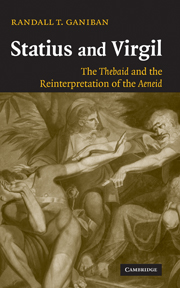Book contents
- Frontmatter
- Contents
- Preface
- List of abbreviations
- 1 Introduction
- 2 Oedipus' curse
- 3 Horror, prophecy, and the gods
- 4 Hypsipyle's narrative of nefas
- 5 Bacchus and the outbreak of war
- 6 Dis and the domination of hell
- 7 Delay and the rout of Pietas
- 8 Spectacle, crime, and monarchy at Thebes
- 9 Pietas, burial, and clementia in a world of nefas
- Works cited
- General index
- Index locorum
9 - Pietas, burial, and clementia in a world of nefas
Published online by Cambridge University Press: 22 September 2009
- Frontmatter
- Contents
- Preface
- List of abbreviations
- 1 Introduction
- 2 Oedipus' curse
- 3 Horror, prophecy, and the gods
- 4 Hypsipyle's narrative of nefas
- 5 Bacchus and the outbreak of war
- 6 Dis and the domination of hell
- 7 Delay and the rout of Pietas
- 8 Spectacle, crime, and monarchy at Thebes
- 9 Pietas, burial, and clementia in a world of nefas
- Works cited
- General index
- Index locorum
Summary
By the end of book 11, the personified goddess Pietas has been routed, and the brothers' duel has intertextually blurred the distinctions between Turnus and Aeneas. Virgilian pietas has been shown to be powerless. But is any ideal capable of countering the violence of nefas? I will answer this question by examining the attempts in book 12 to bury Polynices and the fallen Argive warriors. These episodes reveal the continuing irrelevance of pietas on the political, divine, and intertextual levels, but they also suggest that another virtue can take its place to alleviate human suffering in a relentlessly criminal world. In the end, clementia, embodied by the Athenian king Theseus, offers the solution. But the problems involved in Theseus' clementia, particularly when analyzed in a Stoic framework, share in the overall complexities of Thebes' nefas-infested world. In the Thebaid, where kingship is autocracy and autocracy enables crime, clementia, while a potentially positive force, is nevertheless a flawed and confused ideal, a result and symptom of absolute power.
ANTIGONE, ARGIA, AND CREON'S BURIAL PROHIBITION
The deaths of Eteocles and Polynices do not end nefas at Thebes. Nor do they resolve Oedipus' madness, which had set the Thebaid in motion. Indeed the Theban world is even more terrifying because nefas outlives the brothers' hatred. Oedipus, though he temporarily experiences feelings of pietas and clementia after the duel, reaches the end of book 11 as crazed as he was at the beginning of the epic.
- Type
- Chapter
- Information
- Statius and VirgilThe Thebaid and the Reinterpretation of the Aeneid, pp. 207 - 232Publisher: Cambridge University PressPrint publication year: 2007



